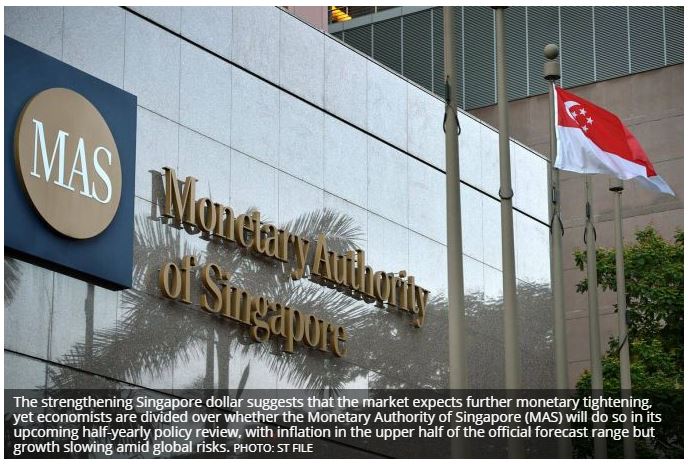Singapore: Market expects MAS tightening, but economists divided
THE strengthening Singapore dollar suggests that the market expects further monetary tightening, yet economists are divided over whether the Monetary Authority of Singapore (MAS) will do so in its upcoming half-yearly policy review, with inflation in the upper half of the official forecast range but growth slowing amid global risks.
At the last review in April, the MAS ended two years of neutral policy and moved to a modest and gradual appreciation path, in the first monetary tightening in six years. With the next policy statement to come Oct 12, the jury is still out on the likely decision, said OCBC head of treasury research and strategy Selena Ling.
Said Ms Ling: “The August inflation data presents a temporary setback to hawkish expectations, but we still anticipate the MAS core inflation to cross the 2 per cent year-on-year handle soon amid a relatively resilient domestic economy and notwithstanding the escalating United States-China trade tensions.”
Headline inflation was 0.7 per cent in August, while core inflation stood at 1.9 per cent for the second straight month, maintaining the fastest rate of increase since August 2014.
Current MAS policy has the Singapore dollar on “a modest and gradual appreciation path”, letting it rise against the currencies of major trading partners within an undisclosed trading band. The April decision increased the upward slope of this S$NEER (nominal effective exchange rate) band, without changing its width or the level where it is centred.
With Singapore on track for at least 3 per cent growth in 2018, “a slight steepening of the slope would not look out of whack”, said Ms Ling.
Deutsche Bank chief economist Juliana Lee and ANZ Research analysts Khoon Goh and Irene Cheung are among those who expect the slope to rise to 1 per cent per annum, from the current assumed 0.5 per cent per annum. Added the ANZ analysts: “The strengthening in the S$NEER towards the upper bound suggests that the market is pricing in a high probability of a tightening move.”
They noted that April’s move took into account the trade tensions, and that while these have escalated, MAS managing director Ravi Menon said in a recent speech that global growth has shown resilience in the face of mounting uncertainties. “Hence, this characterisation of a resilient global backdrop is likely to be emphasised in the October (decision).”
Citi analysts see a 70 per cent chance of a 0.5 percentage-point steepening, and a 15 per cent chance of a more aggressive 1 percentage-point steepening, “given MAS’ historically greater weight placed on expected inflation in its policy bias”.
Nomura analysts Craig Chan and Wee Choon Teo similarly expect another “slight” increase in the slope of appreciation, with the two most likely surprise scenarios being that the MAS will maintain the current policy, or tighten even further than expected.
On Sept 28, DBS analysts changed their earlier view that the pick-up in inflation was insufficient to prompt further tightening. They now noted that MAS has scope to increase the gradient by another 0.5 per cent, with both headline and core inflation in the upper half of forecast ranges and full-year growth likely to come in at the stronger half of its range too.
Standard Chartered analysts have gone in the other direction. Having previously expected a further steepening, analysts Edward Lee, Jonathan Koh and Divya Devesh released a note changing their call on Sept 25, and now expect no change.
Their initial expectation was based on their view “that rising inflation warrants further tightening and that the MAS may also want a larger policy buffer before the next downturn”.
But they now expect MAS to maintain the status quo, firstly as “it would be difficult for the MAS to justify any tightening given the recent deterioration in US-China trade relations” and secondly as unit labour costs have been subdued, keeping domestic wage-induced price pressures at bay.
For ING Asia economist Prakash Sakpal, slower GDP growth and steady core inflation under 2 per cent are the reasons he is expecting no change from the MAS. Singapore’s growth was 4.5 per cent in the first quarter and 3.9 per cent in the second, with the Ministry of Trade and Industry expecting a further slowdown in the second half of the year.
UOB senior economist Alvin Liew also expects the MAS to maintain its current policy, noting that services inflation has moderated in recent months. “With the MAS keeping their inflation expectations unchanged, coupled with the backdrop of the ongoing US-China trade dispute which could have negative spillover impact for trade-dependent economies like Singapore and potentially slowing down global economic growth in the quarters ahead, we believe that MAS will lean on the side of caution and will maintain the current monetary policy stance,” he said.
While noting the consensus expectation of tighter policy, Maybank Kim Eng economists Chua Hak Bin and Lee Ju Ye think the MAS is likely to maintain the current stance, “given visible signs of slowing growth”.
Headline inflation remains benign, monetary conditions are already tightening, and the trade war presents downside risks for growth and inflation, they said, placing a roughly 70 per cent probability on MAS holding, and a 30 per cent probability of a shift to a steeper appreciation slope. “What makes this a difficult call for MAS is that core inflation continues to creep higher, while labour market conditions have tightened.”
Source: https://www.businesstimes.com.sg/government-economy/market-expects-mas-tightening-but-economists-divided-0


 Thailand
Thailand




